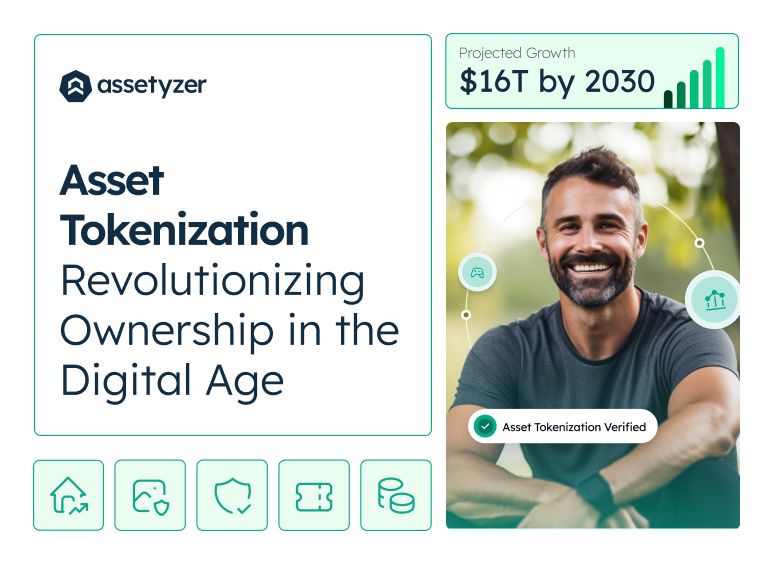Introduction to Asset Tokenization
Asset tokenization has come up as a ground-breaking idea in the always-changing fields of finance and technology that has the potential to completely shift the way we see ownership, investment, and asset exchange. Using blockchain technology, this ground-breaking method produces digital copies of actual assets that are more liquid, safe, and accessible. The principles of asset tokenization, its operation, advantages, and possible effects on several sectors will be covered in this blog.
What is Asset Tokenization?
Asset tokenization is the process of converting physical or intangible assets into digital tokens on a blockchain. These tokens represent ownership or a stake in the underlying asset, allowing for fractional ownership and easier transferability. Virtually any asset can be tokenized, including real estate, stocks, bonds, art, collectibles, and even intellectual property.
How Does Asset Tokenization Work?
- Selection of the Asset: The first step in asset tokenization is identifying the asset to be tokenized. This could be anything from a piece of real estate to a work of art or a financial instrument.
- Valuation and Legal Framework: The asset must be accurately valued, and a legal framework must be established to ensure that the tokens represent a legitimate claim to the asset. This involves regulatory compliance and the creation of smart contracts that govern the token's terms and conditions.
- Token Creation: The asset is divided into smaller units, and digital tokens representing these units are created on a blockchain. Each token typically represents a fraction of the asset's value, allowing for fractional ownership.
- Issuance and Distribution: Once the tokens are created, they can be issued and distributed to investors. This is often done through a security token offering (STO), similar to an initial coin offering (ICO) but focusing on assets with intrinsic value.
- Trading and Exchange: Token holders can trade their tokens on various blockchain-based platforms and exchanges. This provides liquidity and flexibility, enabling investors to easily buy, sell, or trade their tokens.
Real-world examples of Asset Tokenization
- Real Estate: One of the most notable applications of asset tokenization is in the real estate sector. For instance, a luxury apartment building can be tokenized, allowing investors to purchase tokens representing a share in the property. This enables fractional ownership and makes real estate investment accessible to a broader range of investors.
- Art and Collectibles: High-value artworks and collectibles can be tokenized, enabling investors to own a fraction of a piece. This not only democratizes access to valuable art but also provides a new way for artists and collectors to monetize their assets.
- Commodities: Commodities such as gold, oil, and agricultural products can be tokenized, allowing for easier trading and investment. This can increase market efficiency and provide greater liquidity in commodity markets.
- Intellectual Property: Intellectual property rights, including patents, trademarks, and copyrights, can be tokenized. This allows creators to sell or license their rights more easily and provides investors with new opportunities to invest in innovation.
Potential Impact on Various Industries
The potential applications of asset tokenization are vast, and its impact is already being felt across several industries:
- Real Estate: Tokenization can transform the real estate market by enabling fractional ownership and increasing liquidity. Investors can buy tokens representing a portion of a property, making real estate investment more accessible and flexible.
- Art and Collectibles: The art market can benefit from tokenization by allowing collectors to own and trade fractions of high-value artworks. This opens up the market to a wider audience and increases the liquidity of valuable art pieces.
- Finance: The tokenization of financial instruments such as stocks, bonds, and commodities can enhance liquidity, reduce transaction costs, and provide greater transparency. This can lead to more efficient and accessible financial markets.
- Intellectual Property: Creators can tokenize intellectual property, such as patents or copyrights, allowing for fractional ownership and easier transfer of rights. This can create new revenue streams and increase the value of intellectual property.
Challenges and Considerations
While asset tokenization offers many benefits, it also comes with its own set of challenges and considerations:
- Regulatory Compliance: The regulatory landscape for asset tokenization is still evolving, and navigating the legal requirements can be complex. It is essential to ensure that tokenized assets comply with relevant regulations to avoid legal issues.
- Technology and Security: Ensuring the security and reliability of the underlying blockchain technology is crucial. Vulnerabilities in smart contracts or blockchain networks can pose risks to tokenized assets.
- Market Acceptance: Widespread adoption of asset tokenization requires market acceptance and the development of robust infrastructure for trading and exchanging tokens. Building trust and confidence in the technology is essential for its success.
- Valuation and Liquidity: Accurately valuing tokenized assets and maintaining liquidity in secondary markets can be challenging. Ensuring that tokens retain their value and are easily tradable is critical for investor confidence.
Conclusion
Asset tokenization represents a significant shift in the way we think about ownership and investment. By leveraging blockchain technology, tokenization offers increased liquidity, fractional ownership, enhanced security, and reduced costs. As the technology matures and regulatory frameworks develop, the potential applications of asset tokenization will continue to expand, transforming industries and creating new opportunities for investors worldwide. Embracing this innovative approach can unlock the value of assets and democratize investment opportunities, paving the way for a more inclusive and efficient financial ecosystem.
